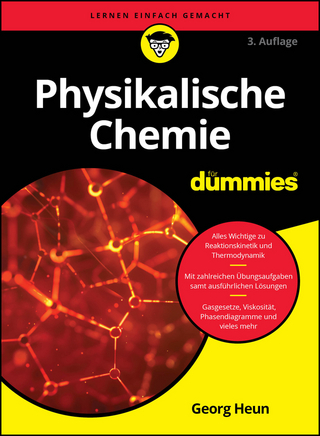
Fundamentals and Practice in Statistical Thermodynamics
John Wiley & Sons Inc (Verlag)
978-1-394-16142-3 (ISBN)
Thermodynamics is a discipline which straddles the fields of chemistry, physics, and engineering, and has long been a mainstay of undergraduate and graduate curricula. Conventional thermodynamics courses, however, often ignore modern developments in statistical mechanics, such as molecular simulation methods, cooperative phenomena, phase transitions, universality, as well as liquid-state and polymer theories, despite their close relevance to both fundamental research and engineering practice.
»Fundamentals and Practice in Statistical Thermodynamics« fills this gap with an essential book that applies up-to-date statistical-mechanical techniques to address the most crucial thermodynamics problems found in chemical and materials systems.
It is ideally suited to introduce a new generation of researchers and molecular engineers to modern thermodynamic topics with numerous cutting-edge applications.
From »Fundamentals and Practice in Statistical Thermodynamics« readers will also find:
- An introduction to statistical-mechanical methods including molecular dynamics simulation, Monte Carlo simulation, as well as the molecular theories of phase transitions, classical fluids, electrolyte solutions, polymeric materials, and more
- Illustrative examples and exercise problems with solutions to facilitate student understanding
- Supplementary online materials covering the basics of quantum mechanics, density functional theory, variational principles of classical mechanics, intermolecular interactions, and many more subjects
Jianzhong Wu, PhD, is a member of the faculty of the Deparmtnet of Chemical and Environmental Engineering and the cooperating/collaborating faculty of Bioengineering, Materials Science and Engineering, and Mathematics Department at the University of California, Riverside. He is an elected fellow fo the American Physical Society and the American Institute for Medical and Biological Engineering
John M. Prausnitz, PhD, is a professor of chemical engineering at the University of California, Berkeley. He is a member of the National Academy of Sciences, National Academy of Engineering, and American Academy of Arts and Sciences. He is also a recipient of the National Medal of Science in recognition of his pioneering work on engineering-oriented molecular thermodynamics.
Chapter 1 Microscopic Origin of Thermodynamics
1.1 Microscopic constituents of thermodynamic systems
1.2 Thermodynamic relations
1.3 Microscopic uncertainty, ensemble average, and ergodicity
1.4 Entropy and information
1.5 Ab initio thermodynamics
1.6 Statistical-mechanical models
1.7 Additivity and relativity of thermodynamic quantities
Problems
Chapter 2 Statistical Ensembles and MD Simulation
2.1 Microcanonical ensemble
2.2 Basics of MD simulation
2.3 Canonical ensemble
2.4 Thermostat methods in MD
2.5 Langevin dynamics
2.6 Fluctuation-dissipation theorem
2.7 Isobaric-isothermal ensemble
2.8 Isobaric molecular dynamics
2.9 Grand canonical ensemble
2.10 Transformation between ensembles
2.11 Generalized ensembles
Appendix 2A Virial theorem
Appendix 2B The Nosé–Hoover thermostat
Problems
Chapter 3 Ideal Gases and Single-Molecule Thermodynamics
3.1 Non-interacting systems
3.2 Monatomic ideal gases
3.3 Diatomic molecules
3.4 Polyatomic molecules
3.5 Chemical equilibrium
3.6 Gas adsorption at solid surfaces and in porous materials
3.7 Thermodynamics of gas hydrates
3.8 Ideal polymer chains and freely-jointed chain model
3.9 Gaussian chain models
3.10 Statistics of ideal copolymer chains
3.11 Worm-like chain model
3.12 Random-walk models
Problems
Chapter 4 Thermodynamics of Light, Electrons and Phonons
4.1. Quantum particles
4.2. Quantum statistics
4.3. Thermodynamics of light
4.4. Radiation and solar energy conversion
4.5. Electrons in metallic systems
4.6. Ideal solids and phonons
Problems
Chapter 5 Cooperative Phenomena and Phase transitions
5.1 Spins and ferromagnetism
5.2 The Ising chain
5.3 Ionization of weak polyelectrolytes
5.4 Helix-coil transition
5.5 2D Ising models
5.6 Mean-field methods
5.7 Lattice models
5.8 Order parameters and phase transition
5.9 The Landau theory
5.10 Microemulsion and liquid crystals
5.11 Critical phenomena and universality
5.12 Renormalization group theory
5.13 Generalized Ising models
Appendix 5A The partition function of an Ising chain
Problems
Chapter 6 Monte Carlo Simulation
6.1 Importance sampling
6.2 Monte Carlo moves
6.3 Metropolis-Hastings algorithm
6.4 Monte Carlo simulation for the Ising chain
6.5 Simulation size
6.6 Simulation of simple fluids
6.7 Biased sampling methods
6.8 Free-energy calculations
6.9 Simulation of crystalline solids
6.10 Phase-equilibrium simulation
6.11 Histogram reweighting analysis
6.12 Enhanced sampling methods
Appendix 6A The Markov chain process
Problems
Chapter 7 Simple Fluids and Colloidal Dispersions
7.1 Microstates in the phase space
7.2 Radial distribution function and structure factor
7.3 Structure-property relations
7.4 Integral equation theories
7.5 Hard-sphere model
7.6 The sticky hard-sphere model
7.7 van der Waals theory
7.8 Cell model for colloidal crystals
7.9 Order through entropy
7.10 Colloidal phase diagrams and protein crystallization
7.11 Perturbation theories
7.12 Critical behavior of fluid-fluid transition
7.13 Molecular theory of critical phenomena
Appendix 7A Thermodynamic properties of hard-sphere mixtures
Appendix 7B The radial distribution functions of the Lennard-Jones mixtures
Appendix 7C Critical behavior of integral-equation theories
Problems
Chapter 8 Polymer Solutions, Blends and Complex Fluids
8.1 The Flory-Huggins theory
8.2 Polymer phase behavior
8.3 Statistical mechanics of polymeric fluids
8.4 Equations of state for hard-sphere chains
8.5 Statistical associating fluid theory (SAFT)
8.6 Random phase approximation
8.7 Self-consistent field theory
Summary
Appendix 8A Calculus of variations
Appendix 8B Gaussian integrals
Appendix 8C Basics of field theory
Appendix 8D Statistical mechanics of non-uniform ideal gases
Problems
Chapter 9 Solvation, Electrolytes and Electric Double Layer
9.1 The McMillan-Mayer theory
9.2 Phenomenological solvation models
9.3 Solvent-mediated interactions and colloidal forces
9.4 Electrostatics in dilute electrolytes
9.5 The extended Debye-Hückel theories
9.6 Integral-equation theories for ionic systems
9.7 Statistical behavior of polyelectrolyte chains
9.8 Polyelectrolyte cell model and the counterion-condensation theory
9.9 Liquid-state theories of polyelectrolyte solutions and complexes
9.10 Electric double layer
Summary
Appendix 9A The Hamaker theory of van der Waals interactions
Problems
Index
| Erscheinungsdatum | 22.08.2024 |
|---|---|
| Verlagsort | New York |
| Sprache | englisch |
| Gewicht | 1202 g |
| Einbandart | gebunden |
| Themenwelt | Naturwissenschaften ► Chemie ► Physikalische Chemie |
| Naturwissenschaften ► Chemie ► Technische Chemie | |
| Naturwissenschaften ► Physik / Astronomie ► Thermodynamik | |
| Technik | |
| ISBN-10 | 1-394-16142-5 / 1394161425 |
| ISBN-13 | 978-1-394-16142-3 / 9781394161423 |
| Zustand | Neuware |
| Informationen gemäß Produktsicherheitsverordnung (GPSR) | |
| Haben Sie eine Frage zum Produkt? |
aus dem Bereich


